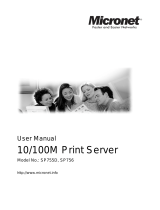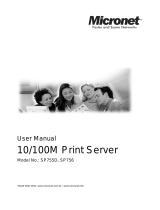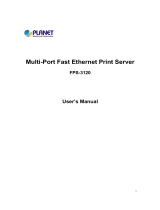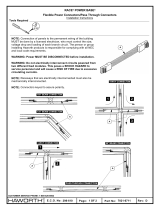
Fast Ethernet Print Server
User’s Manual
Version: 1.0(July, 2005)

COPYRIGHT
Copyright ©2005/2006 by Edimax Technology. All rights reserved. No part of this
publication may be reproduced, transmitted, transcribed, stored in a retrieval system, or
translated into any language or computer language, in any form or by any means,
electronic, mechanical, magnetic, optical, chemical, manual or otherwise, without the prior
written permission of this company.
Federal Communication Commission
Interference Statement
This equipment has been tested and found to comply with the limits for a Class B digital
device, pursuant to Part 15 of FCC Rules. These limits are designed to provide
reasonable protection against harmful interference in a residential installation. This
equipment generates, uses, and can radiate radio frequency energy and, if not installed
and used in accordance with the instructions, may cause harmful interference to radio
communications. However, there is no guarantee that interference will not occur in a
particular installation. If this equipment does cause harmful interference to radio or
television reception, which can be determined by turning the equipment off and on, the
user is encouraged to try to correct the interference by one or more of the following
measures:
1. Reorient or relocate the receiving antenna.
2. Increase the separation between the equipment and receiver.
3. Connect the equipment into an outlet on a circuit different from that to which the
receiver is connected.
4. Consult the dealer or an experienced radio technician for help.
FCC Caution
This equipment must be installed and operated in accordance with provided instructions
and a minimum 20 cm spacing must be provided between computer mounted antenna and
person’s body (excluding extremities of hands, wrist and feet) during wireless modes of
operation.
This device complies with Part 15 of the FCC Rules. Operation is subject to the following
two conditions: (1) this device may not cause harmful interference, and (2) this device
must accept any interference received, including interference that may cause undesired
operation.
Any changes or modifications not expressly approved by the party responsible for
compliance could void the authority to operate equipment.

Federal Communication Commission (FCC) Radiation Exposure Statement
This equipment complies with FCC radiation exposure set forth for an uncontrolled
environment. In order to avoid the possibility of exceeding the FCC radio frequency
exposure limits, human proximity to the antenna shall not be less than 20cm (8 inches)
during normal operation.
The antenna(s) used for this transmitter must not be co-located or operating in conjunction
with any other antenna or transmitter.
R&TTE Compliance Statement
This equipment complies with all the requirements of DIRECTIVE 1999/5/EC OF THE
EUROPEAN PARLIAMENT AND THE COUNCIL of March 9, 1999 on radio equipment
and telecommunication terminal Equipment and the mutual recognition of their conformity
(R&TTE)
The R&TTE Directive repeals and replaces in the directive 98/13/EEC
(Telecommunications Terminal Equipment and Satellite Earth Station Equipment) As of
April 8, 2000.
Safety
This equipment is designed with the utmost care for the safety of those who install and use
it. However, special attention must be paid to the dangers of electric shock and static
electricity when working with electrical equipment. All guidelines of this and of the
computer manufacture must therefore be allowed at all times to ensure the safe use of the
equipment.
EU Countries Intended for Use
The ETSI version of this device is intended for home and office use in Austria, Belgium,
Denmark, Finland, France, Germany, Greece, Ireland, Italy, Luxembourg, the Netherlands,
Portugal, Spain, Sweden, and the United Kingdom.
The ETSI version of this device is also authorized for use in EFTA member states: Iceland,
Liechtenstein, Norway, and Switzerland.
EU Countries Not intended for use
None.
DISCLAIMER
This company makes no representations or warranties, either expressed or implied, with
respect to the contents hereof and specifically disclaims any warranties, merchantability or
fitness for any particular purpose. Any software described in this manual is sold or
licensed "as is". Should the programs prove defective following their purchase, the buyer
(and not this company, its distributor, or its dealer) assumes the entire cost of all
necessary servicing, repair, and any incidental or consequential damages resulting from
any defect in the software. Further, this company reserves the right to revise this
publication and to make changes from time to time in the contents hereof without
obligation to notify any person of such revision or changes.

Contents
1. PRODUCT INTRODUCTION 1.1 PRODUCT
INTRODUCTION................................................................................1
1.3 Network Printing Architecture.............................................2
Print Server Network Functions...................................................................2
Network Printing Functions for Clients.......................................................3
Network Printing Functions for Network Server.........................................5
1.4 Network Printing Environment............................................6
1.6 Firmware & Printing Function.............................................8
3. WINDOWS PEER-TO-PEER NETWORK 3.1 SYSTEM
ARCHITECTURE...............................................................................9
3.2 Administrator Installation and Setup.................................10
3.4 Client Installation and Setup............................................16
3.5 Client Utilities...................................................................20
3.5.1 Network Ports Quick Setup...........................................................20
3.5.2 Remote Ports (Utility)......................................................................21
3.6 Windows Add Printer Procedure...................................24
4. WINDOWS NT/2000/2003 NETWORK 4.1 SYSTEM
ARCHITECTURE.............................................................................28
4.2 Windows NT/2000/2003 Server Installation and Setup.....29
4.3 User Installation and Setup..............................................30
5. NETWARE NETWORK 5.1 SYSTEM
ARCHITECTURE.............................................................................31
5.2.1 Installation Using PCONSOLE .......................................................32
6. UNIX SYSTEM NETWORK 6.1 INTRODUCTION....35
6.3.1 DHCP...............................................................................................36
6.3.2 BOOTP.............................................................................................36
7. CONFIGURATION UTILITY 7.1 INTRODUCTION..39
7.3 Status of Print Server.......................................................41
7.4 Setup the Print Server......................................................42
7.5 AppleTalk Configuration...................................................43
7.6 General Configuration......................................................44
7.7 Netware Print Server Configuration..................................45
7.8 System Configuration.......................................................46

7.9 TCP/IP Configuration.......................................................48
7.10 Wireless Configuration...................................................50
7.11 SNMP Configuration......................................................57
8. WEB MANAGEMENT 8.1 INTRODUCTION.......62
8.3 Device Status..................................................................63
8.3.1 System..............................................................................................63
8.3.2 Printer..............................................................................................63
8.3.3 TCP/IP.............................................................................................64
8.3.4 SMB................................................................................................64
8.3.5 SNMP..............................................................................................65
8.3.6 NetWare..........................................................................................65
8.3.7 AppleTalk........................................................................................66
8.4.1 System...........................................................................................66
8.4.2 Advanced Settings............................................................................67
8.4.3 TCP/IP............................................................................................68
8.4.4 SMB..............................................................................................69
8.4.5 SNMP............................................................................................69
8.4.6 NetWare........................................................................................70
8.4.7 AppleTalk......................................................................................71
8.4.8 Save Settings .................................................................................72
8.5 System Tools................................................................73
8.5.1 Load Default .................................................................................73
8.5.2 Upgrade Firmware from Browser.................................................73
9.2 System Setup.................................................................75
9.2.1 Print Server Side ...........................................................................75
9.2.2 Client Side.....................................................................................75
10. WINDOWS XP SP2 SETUP..................................................78

1. Product Introduction
1.1 Product Introduction
Thank you for purchasing and using our print server. This
print server allows your printer to become a shared device
on the network. It offers printing flexibility and
manageability on your Local Area Network at an extremely
low cost and with an absolute minimum setup and
maintenance required.
This print server provides IEEE 802.11g/b wireless LAN (up
to 54Mbps data transfer rate), an Ethernet network port
(10/100Mbps Ethernet) and one print port for printer.
This print server supports IPX/SPX, NetBEUI, TCP/IP and
AppleTalk protocols. It is the best network printing
solutions for various common network operating systems
such as Windows 95/98/Me/NT/2000/XP/2003, NetWare,
Unix/Linux and MAC OS, etc.
With the help of Installation Wizard, you can easily and
instantly complete the settings for the printing environment,
and start enjoying the fantastic features provided by the
print server.
In the following chapters, we will introduce in detail the
printing features, installation methods, and system
configuration for different network environments.
If you would like to set up and install print server quickly,
please refer to the Quick Installation Guide that comes
along with this print server.
1.2 Product Package
This package contains the following components:
z One Print Server
z One Antenna
z One Power Adapter
z One Quick Installation Guide
z One CD-ROM (Including all the software utilities, drivers and User’s Manual)
1

1.3 Network Printing Architecture
This section illustrates how print server functions and
operates on the network. Before you install and use print
server, it is strongly recommended that you read this
section completely, and select only the chapters you need
according to your network operating system by “Contents of
the User’s Manual” in next section.
This section will first introduce the role every component
plays in the network-printing environment.
Print Server
Client User
Network Server (optional)
Wind ows NT S erver
NetWare Server
Windows 98Wind ows NT
Workstation
Windows 2000
Unix Pr in t Serv er
Network Printing Environment
Print Server
Client User
Network Server
Print Server Network Functions
Windows NT Server
NetWare Serv er
Windows 98Windows NT
Workstation
Wind ows 2 00 0
Unix Print Server
Print Server
Because print server supports IPX/SPX, NetBEUI, TCP/IP
and AppleTalk network protocols, any networked computer
2

can directly print to the print server from any of its installed
protocol.
Network Printing Functions for Clients
Windows NT Server
NetWare Serv er
Windows 98Windows NT
Workstation
Wind ows 2 00 0
Unix Print Server
Client User
Common operating systems for clients are classified as
following:
Windows 95/98/Me/NT/2000/XP/2003
Our print server system provides PTPP (Peer-to-Peer
Printing) driver and utilities for Windows
95/98/Me/NT/2000/XP/2003 users. PTPP (Peer-to-Peer
Printing) supports TCP/IP protocol.
3

In the client installation procedure, after PTPP (Peer-to-
Peer Printing Driver) is installed into Windows, the system
will automatically (manual configuration is also allowed)
search all the print servers on the network, and then add
their printing ports into Windows’ printing port (see below).
Windows 98
PTPP
Print Server
MIS-2
P1
P2
P3
P1
Print Server
MIS-1
UNIX / Linux
UNIX (include HP/UX, SCO Unix, SunOS, Solaris, Unixware
DECUnix, IBM AIX and others) and Linux use the system-
standard LPR to print through print server.
MAC OS
MAC OS can use the system-standard AppleTalk network to
print through print server.
4

Network Printing Functions for Network Server
Windows NT Server
NetWare Serv er
Windows 98Windows NT
Workstation
Wind ows 2 00 0
Unix Print Server
Network Server
Common network servers are classified as following:
Windows NT/2000/2003
Our print server system provides PTPP (Peer-to-Peer
Printing) driver and utilities for Windows NT/2000/2003.
After PTPP is installed, the server can directly print through
print server. Adding this printing function into Windows
NT/2000/2003 Server allows print queue, user authority
management, and many other advanced features to be
used.
NetWare 3.x/4.x/5.x
In NetWare environment, print server offers various printing
modes like print queue, remote printer, etc.
5

1.4 Network Printing Environment
Common network environment are classified as following:
Windows Peer-to-Peer Network
The client’s PTPP driver will use TCP/IP protocol to print
through print server.
Windows NT/2000/2003 Network
Network printing function will become available after PTPP
driver is installed into Windows NT/2000/2003. Adding this
printing function into Windows NT/2000/2003 Server allows
print queue, user authority management, and many other
advanced features to be used.
NetWare Network (see below)
6

1.5 Contents of the User’s Manual
Chapter 2 explains print server’s hardware installation and
configuration. It is strongly recommended for you to read.
The following chapters introduce:
Chapter 3. Windows Peer-to-Peer Network
Chapter 4. Windows NT/2000/2003 Server-Based Network
Chapter 5. NetWare Network
Chapter 6. UNIX System Network
You may select the appropriate chapters and sections to
read depending on your network printing’s requirement.
Chapter 7 and chapter 8 introduce print server’s
management and configuration utilities on Windows and
Web Browser’s environment respectively. You may select
the appropriate management utility according to the
administrator’s computer platform.
Chapter 9 introduces Print Server’s IPP Printing function
and setup procedure. The IPP Printing provides a
convenient way to print documents across the Internet by
the IPP protocol.
Chapter 10 introduces how to deal with the problem that if
you can’t find any print server listed on the “Available
Ports” in “Network Ports Quick Setup” in Windows XP SP2.
7

1.6 Firmware & Printing Function
The print server provides a complete network printing
solution. The feature set is listed below:
PTPP (Peer-to-Peer-Printing)
TCP/IP (LPR)
IPP Printing
NetWare Bindery Printing
AppleTalk
SMB Printing
2. Hardware Installation
Unpack the print server package and verify that all the
items listed in the section 1.2 are provided.
Connect the print server to the printer you want to share on
the network.
Connect the print server to your network by attached the
network cable to the UTP port of the print server.
Connect the power adapter to the print server. The print
server will perform the Power-On-Self-Test (POST) after it
is powered on. During the POST, the Status and Ready
LEDs will be on. When the LEDs are unlighted, the print
server is ready.
NOTE1: MUST use the power adapter shipped with the print server, do
NOT use any other power adapter from any sources.
NOTE2: To prevent the compatibility problem between print server and
a few printer, it is recommended that you power on the print server
before the printer.
8

3. Windows Peer-to-Peer Network
3.1 System Architecture
Print server supports Windows Peer-to-Peer network
printing mode, which is suitable for most medium and small
network environments. Through quick and simple
installation procedure, users can immediately enjoy the
convenience of network printing.
Installation procedure is separated into following two parts:
1. Administrator Installation and Setup (refer to section 2
for more detailed information).
System administrators must:
Install administrator’s utilities into his/her computer.
Configure print server from administrator’s configuration
utility.
2. Client Installation and Configuration (refer to section 3
for more detailed information).
Client users must install Windows PTPP driver (Peer-to-
Peer Printing) for network printing.
In addition, after PTPP is installed, the system will
automatically search for all print servers on the network,
and add the printing port of the print servers into Windows’
printing port (refer to Network Printing Architecture in
section 1.4 for more detailed information).
9

3.2 Administrator Installation and Setup
The Administrator Installation can be performed on
Windows 95/98/Me/NT/2000/XP/2003 with the same user
interface. Before the installation, please verify that your
network protocol is installed on your PC (TCP/IP, IPX
and/or NetBEUI).
Insert the CD shipped along with the print server into your
CD-ROM drive. The Autorun.exe program should be
executed automatically. If not, run Autorun.exe manually
from CD-ROM drive’s root directory.
The “Installation Manager” will be displayed on the screen
as following. Click “Admin Utility” then click “English
Version” .
10

The “Utilities Setup” window will be displayed. Click “Next”.
Click “Next” to install the utilities in the default folder or
click “Browse” to specify the destination folder where you
would like to install the utilities.
Select the components you want to install. It is highly
recommended to install all provided components. Click
“Next” to continue.
Specify the program folder where the program icons will be
added to, click “Next”
11

.
The system will start to install the utilities automatically.
12

You have completed the installation phase and prepare to
configure the Print Server. The “Choose Print Server” will
list all Print Servers within the network. Select the Print
Server you would like to configure and click “Next”.
NOTE 1: If this is the first time you configure the Print Server, the “Print Server
Name” is the last 6-digit of MAC ID with prefix “PS”. Please check
the MAC ID on the print server.
NOTE 2: The list can only display the devices from the same manufacturer.
Specify a recognizable name for the Print Server and click
“Next”.
13

Specify the IP Address for the Print Server manually or
click “Next” to keep default IP Address, i.e. 192.168.2.2.
The configuration summary is displayed in the window. Now,
you have completed the “Print Server Setup”. Click “Finish”
and your system will add network port of the Print Server to
your PC automatically.
The Administrator Installation procedure is totally
completed. Click “Finish”.
14

The Administrator Installation Program have executed the
installation procedure that performs the following tasks:
Install all utilities and drivers to the administrator’s PC.
Configure the print server (including the print server name
and network protocol)
Add the network port of the print server to the
administrator’s PC.
If you want to print from this administrator’s PC to the print
server, all you need to do is to perform Windows’ standard
“Add Printer” procedure (please refer to Section 3.6).
3.3 Administrator Utilities
After Administrator Installation is completed, there will be
four utilities in print server’s program folder.
.
15
Page is loading ...
Page is loading ...
Page is loading ...
Page is loading ...
Page is loading ...
Page is loading ...
Page is loading ...
Page is loading ...
Page is loading ...
Page is loading ...
Page is loading ...
Page is loading ...
Page is loading ...
Page is loading ...
Page is loading ...
Page is loading ...
Page is loading ...
Page is loading ...
Page is loading ...
Page is loading ...
Page is loading ...
Page is loading ...
Page is loading ...
Page is loading ...
Page is loading ...
Page is loading ...
Page is loading ...
Page is loading ...
Page is loading ...
Page is loading ...
Page is loading ...
Page is loading ...
Page is loading ...
Page is loading ...
Page is loading ...
Page is loading ...
Page is loading ...
Page is loading ...
Page is loading ...
Page is loading ...
Page is loading ...
Page is loading ...
Page is loading ...
Page is loading ...
Page is loading ...
Page is loading ...
Page is loading ...
Page is loading ...
Page is loading ...
Page is loading ...
Page is loading ...
Page is loading ...
Page is loading ...
Page is loading ...
Page is loading ...
Page is loading ...
Page is loading ...
Page is loading ...
Page is loading ...
Page is loading ...
Page is loading ...
Page is loading ...
Page is loading ...
Page is loading ...
Page is loading ...
Page is loading ...
-
 1
1
-
 2
2
-
 3
3
-
 4
4
-
 5
5
-
 6
6
-
 7
7
-
 8
8
-
 9
9
-
 10
10
-
 11
11
-
 12
12
-
 13
13
-
 14
14
-
 15
15
-
 16
16
-
 17
17
-
 18
18
-
 19
19
-
 20
20
-
 21
21
-
 22
22
-
 23
23
-
 24
24
-
 25
25
-
 26
26
-
 27
27
-
 28
28
-
 29
29
-
 30
30
-
 31
31
-
 32
32
-
 33
33
-
 34
34
-
 35
35
-
 36
36
-
 37
37
-
 38
38
-
 39
39
-
 40
40
-
 41
41
-
 42
42
-
 43
43
-
 44
44
-
 45
45
-
 46
46
-
 47
47
-
 48
48
-
 49
49
-
 50
50
-
 51
51
-
 52
52
-
 53
53
-
 54
54
-
 55
55
-
 56
56
-
 57
57
-
 58
58
-
 59
59
-
 60
60
-
 61
61
-
 62
62
-
 63
63
-
 64
64
-
 65
65
-
 66
66
-
 67
67
-
 68
68
-
 69
69
-
 70
70
-
 71
71
-
 72
72
-
 73
73
-
 74
74
-
 75
75
-
 76
76
-
 77
77
-
 78
78
-
 79
79
-
 80
80
-
 81
81
-
 82
82
-
 83
83
-
 84
84
-
 85
85
-
 86
86
Edimax PS1206U Datasheet
- Category
- Print servers
- Type
- Datasheet
Ask a question and I''ll find the answer in the document
Finding information in a document is now easier with AI
Related papers
Other documents
-
Conceptronic C54PSERVU User manual
-
LevelOne FPS-9022 User manual
-
MicroNet SP766 User manual
-
 MicroNet Technology SP756 User manual
MicroNet Technology SP756 User manual
-
 MicroNet Technology SP756 User manual
MicroNet Technology SP756 User manual
-
LevelOne WPS-9121 User manual
-
Edimax Technology PS-3103P User manual
-
Techno Source Printies 14411 User manual
-
 Planet Technology FPS-3120 User manual
Planet Technology FPS-3120 User manual
-
 Haworth 7021-6711d Operating instructions
Haworth 7021-6711d Operating instructions

























































































